The Northrop F-5 Enthusiast Page - Home

Imperial
Iranian Air Force / Nirou Havai Shahanshaiye Iran / نیروی هوایی شاهنشاهی ایران
Credit: Roundels of the world
 Last update 13-11-2023
Last update 13-11-2023
It
is very difficult, as in many countries, to obtain reliable
information about military aviation in Iran. During the Imperial era
most
information has come from outside sources, particularly the USA. There
are slight differences, according to source,
regarding the exact number
of Freedom Fighters supplied.
All
datas given in this section are unofficial, details written
in blue
without underline are not confirmed. To calculate the local (Iranian)
calender
deduct 621 to the Gregorian (Western) calender.
Only confirmation is to
where aircrafts are based as some F-5s have the number of the Air Base where they are based painted on the tail.
Air Bases list:
- Teheran/Mehrabad = 1st Tactical Air Base
- Tabriz
= 2nd Tactical Air Base
- Dezful/Vahdati
= 4th Tactical Air Base
- Akha Jari/Omidieh =
5th Tactical Air Base
- Isfahan/Khatami = 8th Tactical Air Base
- Chah Bahar
= 10th Tactical Air Base
- Mashad
= 14th Forward Air Station
The
Northrop F-5A/B Freedom Fighter era
In
the early 1960's Iran was part of the Central Treaty Pact (CENTO)
defence pact, together with Turkey, Pakistan and the United Kingdom and
sponsored, as main arms supplier, by the USA. The fighter force of the
Imperial Iranian AF (IIAF) consisted in two Squadrons equipped with
Republic F-84G (useless due to their age) at the 1st Tactical Air Base at
Mehrabad AB, and three Squadrons, 52 aircrafts received, of North
American F-86F based at
Dezful-Vahdati AB (35 overhauled out of 51/53 delivered).
At the time the Shah Reza Pahlevi, chief of state and commander of the
Air Force, ordered a
rapid development of the air arm to
establish air supremacy over
its neighbouring Arab countries,
particularly Iraq. Iran was also looking with concern to the Soviet
Union's power.
During a meeting on 19-09-62 about Imperial Iranian Armed Forces requirements
between the Shah and the US ambassador it was agreed that
eight Squadrons of Northrop F-5 would be enough to cover the Air
Force's
new needs.
Later
agreement covered 92 Freedom Fighters for 7 Squadrons of 13 aircrafts
each; the
initial two batches were to be supplied through Military Assistance Program
(MAP) free of
charge under the code Projet "Peace
Enforcer" but the following
aircrafts were paid in full by Iran under Foreign Military Sales agreement. An official US source mentions 92 aircraft, might include a
replacement aircraft for one lost during delivery.
During a visit in USAin June 1964 the Shah of Persia was briefed about the capabilities regarding the Northrop YF-5A ,
On
12-07-64 a decision was made to replace North American F-86s with
Freedom Fighters, cost USD 259
millions, as an initial step to introduce the much more powerful
McDonnel F-4. Iran declined a Soviet offer of
MIG-21 jet fighters. Capability demostration to high level officers was
given at Teheran on 01-08-64 and 02-08-64 by Northrop F-5B
63-08445.
Initial
group of six instructors were trained at Williams AFB starting
September 1964, reaching 55 pilots within a few months. New pilots
obtained their advanced training in USA on Northrop T-38As,
transitioning to
Northrop F-5B and later at Mehrabad AB, checked out by USAF
pilots of the locally based Mobile Training Team; technical personnel
was sent to various USAF schools. The Team remained at least until 1976, training also
on the Northrop F-5E.
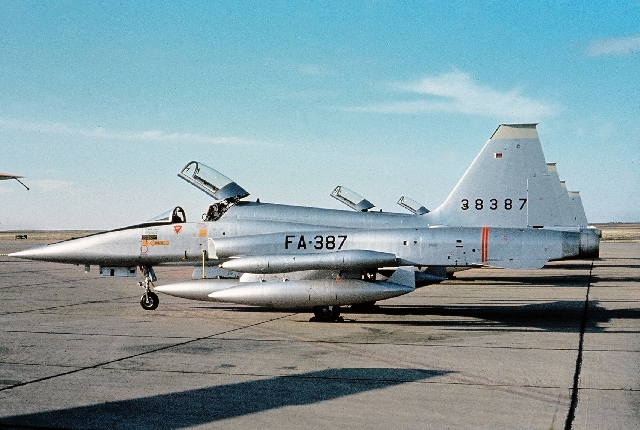
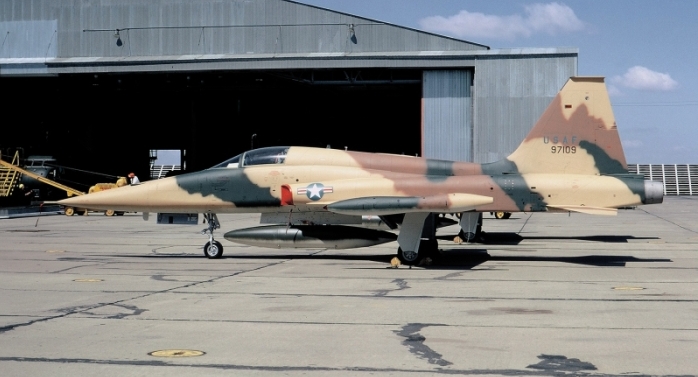
F-5A 38387
FA-387 in USA February 1965 with long range tanks, no nationality
markings
Now camouflaged F-5A
97109 at McCleelan AFB on 10-06-70, before delivery.
Photos: Archives Northrop the F-5 Enthusiast
The
IIAF became the first Air Force to receive Freedom
Fighters, though they remaind owned by the USA, like all MAP supplied
item. First Northrop F-5s were handed over on 04-12-64 in USA at
Brookley AFB
(Alabama)
USAF pilots flew the 11 Northrop F-5A and 3 Northrop
F-5B to Teheran-Mehrabad -Tactical
Fighter Base 1- and delivered officially on 01-02-65 (had arrived on 12-01-65), replacing the North American F-86F of the
101st Tactical
Fighters Squadron. Ca 750 AIM-9B Sidewinder air-to-air missiles were also acquired.
The 103rd Tactical
Fighters Squadron was the newly (on the same date)
established as a Squadron,
becaming already partially operational in June 1965 after 900 flying
hours, when it was officialy declared operational.
It
became actually only operational on July 1965 when two Sidewinders
armed
single-seaters relieved the North American F-86F on alert duties at
Teheran/Mehrabad AB.
During
the summer of 1965 a second unit (101st Tactical Fighter Squadron) was
re-equipped with 7 Northrop F-5A and 2 Northrop F-5B.
The
two-seaters were in high demand in order to train new pilots
locally, while some had to be trained in Pakistan. All pilots
training was for interception ( main training task) given at TAB 1
Mehrabad; AIM-9P-1 were also
delivered and secondary ground
support.
By Jamuary 1966 15 Northrop F-5A and 2 Northrop F-5B were operational ad 7 Northrop F-5A and 2 Northrop F-5B were en-route.
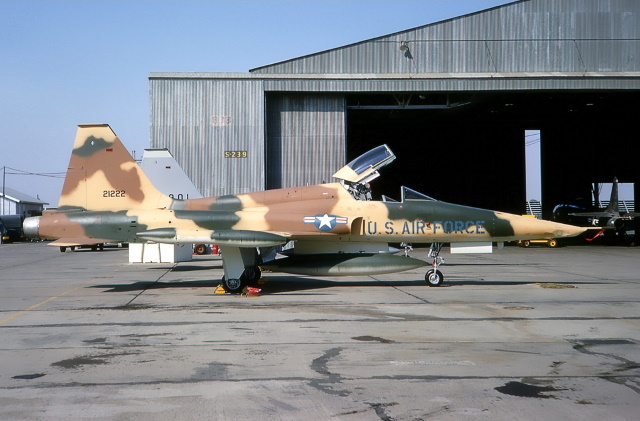
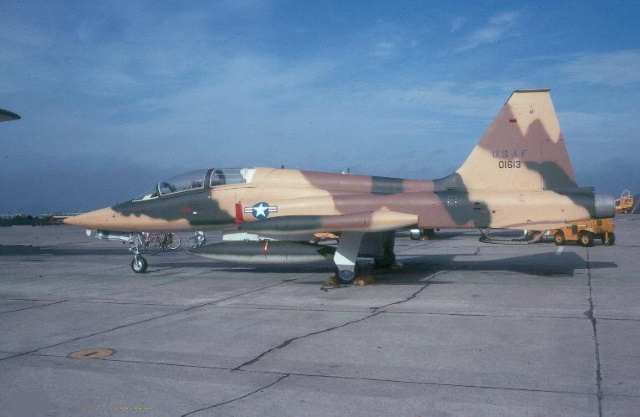
Northrop RF-5A seen at McCleelan AFB on 28-09-68 in
pre-delivery colours
Last Iranian two-seater Freedom Fighter produced, 01613, at McClellan AFB on 05-03-71,
Photo: Doug Olson
still in USAF markings.
Photo: Archives Northrop the F-5 Enthusiast
Completion
of the newly-built Shahroki AB, near Hamadan by end
of 1966/beginning 1967, enabled to base there two Freedon Fighter aircrafts. These
new units were to defend the border area with Iraq.
Air Force commander General Khatami
stated in July 1967 there were four F-5 Squadrons, while US
sources mentioned only 3 Squadrons, one of these being 302nd Fighter
Squadron, unit number not corresponding to
earlier information. Serviceability was high: 85 to 90 percent.
Pilots main mission was interception until the arrival (in 1969) of McDonnel F-4D on 08-09-68 Phantom, when it changed role to ground attack.
New bases were built to house the impressive numbers of new aircrafts and helicopters ordered: 4th Tactical Air
Base, Shiraz starting operation in 1968
5thTactical Air Base, Tabriz starting operation in 1971
6th Tactical Air Base, Bushehir starting operation in 1971
7th Tactical Air Base, Chahbahar starting operation in 1973
8th Tactical Air Base, Izfahan starting operation in 1975
9th Tactical Air Base, Omidieh starting operation in 1978
By
November 1970 following Military Assistance Programm aircrafts had been delivered: 66 Northrop F-5A, 13 Northrop RF-5A and 13 Northrop F-5B. They were in service
with 5 Squadrons
together with two
McDonnell F-4D equipped d Squadrons and 1 North American F-86F Squadron
(in Tabriz, to receive Northrop F-5As). On order were additional 10
Northrop F-5A and 6 F-5B. All F-5As had been
received by January
1971. The
same year Iran decided to replace older Northrop F-5A/F-5B with newer
Northrop F-5E/F-5F and placed orders for 8 Squadrons and the desire shown to
purchase 2 Squadrons more of Tigers.
According to official US sources there were 111 F-5s in use by April 1972; Northrop had 6 technical
representatives in Iran.
A
CIA reports in May 1972 mentions deliveries of Freedom Fighters (all
versions) as follows: in 1965 - 92 (Military Assistance Programm)
delivered as follows: 48 in 1966, 48 in 1967, 4 in 1968, 25 in
1969, 4 in 1970,
15 in
1971. This gives a gand total of 144 aircrafts. Various
other sources mention as follows: 107
Northrop F-5A, 13 Northrop RF-5A and 20 Northrop F-5B, grand total 140
aircrafts. The difference of four missing
aircrafts might be
reconnaissance Northrop RF-5A used for Soviet Union overflights,
see hereunder.
The
Freedom Fighters received active Dissimilar Air Combat Training (DACT)
role in February 1974 with the order of 80 Grumman F-14, to be based at
Isfahan AB which delivery starting from January 1976.
Instructor pilots
first obtained training for the role on the Northrop F-5B, followed on the
Tiger. In Iran one Squadron of Northrop F-5B and F-5E was transferred
contemporanously to Isfahan AB to enable DACT,
while Grumman F-14 pilots flew alternatively McDonnel F-4, Northrop F-5 and the new fighter.
On
July 1975 a leaked information advised tha Northrop would established a
jointly owned assembly plant to manufacture fighter-bombers in Iran.
US government originally approved the facility and then reconsidered
and cancelled the authorisation.
Well placed sources report that Northrop had hoped the regional assmbly
plant would play a role in a sales drive to get Arab states agreed to
make the Tiger their standard fighter.
These opposed to have a
regional supply center in a non-Arab country
Alert bases / Radar chain
Between
1968 and 1975 an enormous effort was made to build radar facilities and
7 new bases to house all new aircrafts ordered (inclusive McDonnell
F-4 transports and helicopters), as at the time there were only
three fighter bases available: Teheran/Mehrabad, Dezful/Vahdati and
Hamadan/Shahroki.
Of relevance to us is was Chah Bahar AB, opened in 1973, housing one Squadron
of F-5 and one Squadron of McDonnell F-4E; the base was mainly
underground and assured the defence
of the narrow Strait of
Hormuz, the only sea passage for petroleum
exporting Persian Gulf states.
The Air
Defense Command, in addition to 14 radar sites,
also had 6 fighters on alert in each air base (2
ships on 5 minutes, 2 ships on 15 minutes, and 2 ships
on 30 minutes alert), a total of 36 fighters. Additionally,
all 79 ships and F-14’s were used for air
defense.
Soviet Union Combat Air Patrol and Overflights - Dark Gene / Projet Ibex
Northrop F-5A flew by1969 regular Combat Air Patrols along the border with the Soviet Union from Mashad Forward Air Station.
Long
range radars and listening points were available to monitor Soviet
activties; Soviet radar coverage had several gaps and low-flying
reconnaissance aircrafts could take helpful photographs.
This
gave
way to the operation named "Dark Gene" with overflights of the Soviet
Union. Northrop RF-5A/F-5B were launched when aircrafts (under Project
Dark Green) were dectectd by the Soviet and radar emissions
could be
collected remaining on the Iranian side pf the border. Not an entirely
Iranian programm, it involved US pilots till 1971s in a top
secret mission and never officially admitted. Two Freedom Fighters were shot
down inside
the Soviet Union in 1969 and 1970, (their pilots being recovered after
emprisonement) as well as 1 Northrop F-5B with an US and one Iranian
pilot.
The Northrop reconnaissance aircrafts were included in the 20 RF-5A supplied, delivered starting from 1968. Officially only 13 Foreign Military Sales
were supplied,
first batch of 13 new built aircrafts; They were
equipped
with additional instruments as other MAP supplied aircrafts.
Four aircrafts were officially never built, 3 are former USAF. Those for this mission were officially never built or supplied to Iran, no information is available. Their construction number was "blacked out" on the production
list, six serials/construction numbers "as not built" and, later, by
2 "white tail" F-5As modified for the
reconnaissance role.
In
1971 the first 6 highly modfied McDonnel RF-4Cs arrived in to replace
the Freedom Fighters, with great pleasure of the American pilots. They were flown by mixed USAF/Iranian crews.
War operation (almost)
During the April 1969 war almost take place against Iraq in the lower part of the river Tigris. Some Northrop F-5s of the 203rd and 204th
Tactical Fighter Squadrons were armed with bombs and rocket launchers
to be
ready for action;while some Northrop RF-5A of the 101st Tactical
Reconnaissance Squadron from Mehrabad AB were used for reconnaissance.
Nortrhrop F-5s, together with North Ameican F-86F flew escort to a
merchant ship carrying Iranian Marines. The crise was finally
peacefully settled, though fighters of the base flew for several years
patrol flights along the Iraqi border.
Further operationa for the same unit based at Zahedan took place during 1972 at the border with Afgahanistan.
International exercises/transfers
Several
Iranian Freedom Fighter pilots received their armament trainingin
Pakistan using Lockheed AT-33A and North American F-86F due to shortage
of Northrop F-5B trainers.
A number of unpublicized encounters with Iraqi MiG-21s have also
taken
place along the Zagros mountains border (North-Western Iran), at least
up to 1970, without any combat action, aircraft remaining on their
respective border side.
Two
joint aerial combat excercises with the Pakistani AF had also been
conducted by 1970; the first one (date not known) consisted in ca.4 Northrop F-5As
and 1 F-5B flying against North American F-86F, the second
in October 1977 between F-5Es
and F-4Ds operating
against Shenyang F-6s (Mig-19s) from Paksitan/Masroor AB. Pakistan was intereste to see the new
Northrop F-5 and evaluate it against their North American F-86.
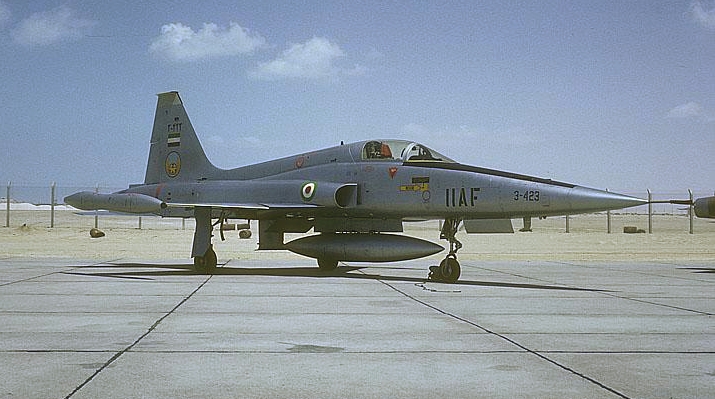
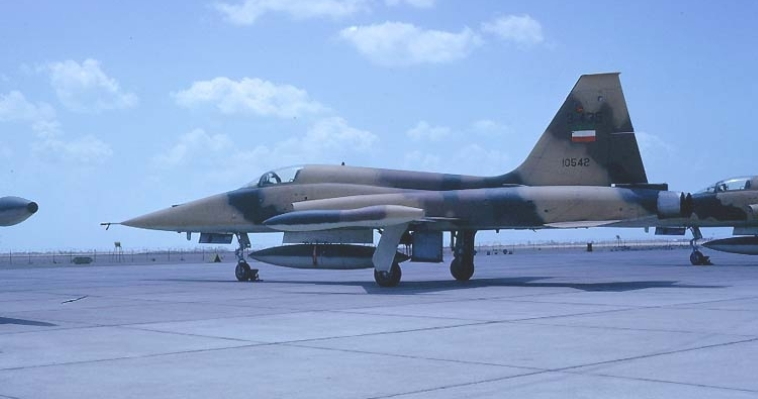
Northrop F-5A 3-423 302
Fighter Squadron at Sharjah AB on 31-03-67
Northrop
F-5A 3-423, 302 Fighter Squadron at Sharjah AB on
31-03-67
Photos : Archives Northrop the F-5 Enthusiast
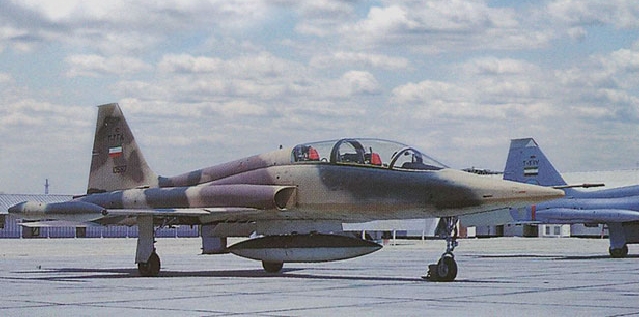
Northrop F-5B 3-438 10587, 302
Fighter Squadron at Sharjah AB on 31-03-67
All photo 31-0-67 : Archives Northrop the F-5 Enthusiast
A detachment of RF-5As were detached to Mehrabad AFB, Tabriz AFB, Vahdati AFB, Shiraz, possibly four each.
Losses
The year 1967 saw the first
accidents, after 2 accidents free years ; three F-5s were lost in the
first seven months, 1 during a ferry flight (delivery?) from Athens,
another two during low-level gunnery training.
Later known
losses are: one F-5 in 1971, and another one during the same year, as well as one in 1974 by
the Golden Crown team.
Maintenance
Maintenace
personnell was a serious factor by the end of 1969. The Shah request
USA to provide own Air Force personnell; possible hiring of Philippines was considered to
provide the needed maintenance.
Freedom Fighter day-to-day maintenance was initially provided by the Air Force
at Teheran-Mehrabad AF, the largest local maintenance basis,
but, with
the increasing number of aircrafts, a new structure had to be
established.
Iran
Aircraft Industries (IACI) was formed as a joint venture with Northrop
Corp. in 1970.
by December 1970 it performed 400, 800 and 1'200 hours
inspections, heavy maintenance and overhaul of the Northrop
F-5s,
their General Electric J-85 engines and built
spare parts. All
work for Northop F-5s was done by locally trained Iranian personnel. Twenty five Freedom
Fighters had undergone ovehaul by 1973, when a new,
very large
facility was under
construction at Mehrabad
airport for
the purpose of again overhauling
aircrafts, building spare parts and training technicians locally.
Transfer/disposal of Freedom Fighters
Even
if mentioned by US official sorces, the supply of 3 Northrop F-5 to
Pakistan in December 1971, during the war with India, is not confirmed
by Pakistani and Iranian sources. They were also mentioned to be
ex-Lybia, which cannot be possible.
The USA also requested the delivery to Yemen of 21 Northrop F-5A, 12 RF-5A and 11 F-5B., transfer that the Shah refused.
Urgent transfer of all F-5s (53 MAP supplied and 37 directly bought) to the Republic of Vietnam AF (under
the US Enhance Plus programm) was requested on 21-10-72 by the US Ambassador in Teheran.
The
Shah
initially opposed it, mentioning that it would weaken the defence
of the country overproportionally, and requested accelerated delivery
of
Northrop F-5Es - scheduled to begin in December 1973. He was
instituing a new
training programm which required a minimum of 53
Northrop F-5A. Finally he
agreed to supply 32
Northrop F-5A in two lots of 16 starting on 31-10-72. Disassembly of the first 16 was
completed by 02-11-72 and
tranferred to S Vietnam on Lockheed
C-5A Galaxy began from Dahdati AB. USA was pleased by the outstanding cooperation
with the personnell of the base.
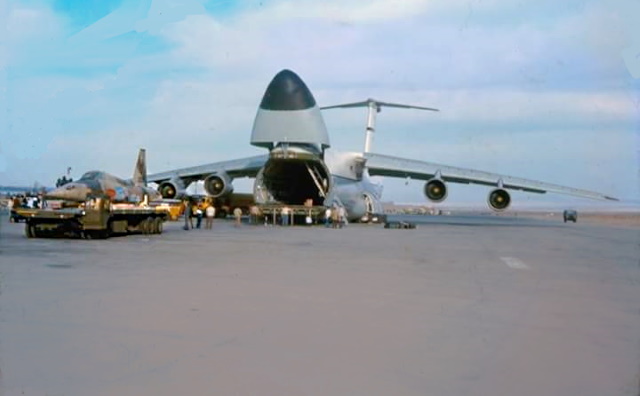
Transfer to South Vietnam of Iranian, camouflaged, Northrop F-5A by Lockheed C-5A Galaxy.
Eight USAF
McDonnel F-4Es were initially leased to overcome the gap in Iranian air defence.
Iran was in any case not interested in the return of the
Northrop F-5As as there was justifiable apprehension regarding Vietnamese
operating conditions and effects of climate and maintenace of
aircrafts. Additionally, by
time of the foreseen return, the Freedom Fighters had been phased out of
inventory by the Air Force. Value of transferred Northrop aircrafts (11,6m USD
- 28 being 5 to 8 years old and 4 three to five years according
to US calculation) was credited against the purchase of new
McDonnell F-4Es.
Next
transfer request came 1974 when Jordan asked Northrop F-5s to modernise
its Air Force. The request consisting of was accepted. It consisted
in 20 Northrop F-5As and 2 F-5Bs as well as spare-parts. In-flight
delivery of 2 initial examples (ex Vahdati AB) was from Mehrabad AB in
March 1974. Ten additional single-seaters and 2 double-seaters were
transferred by 22-05-75, 6 additional arrived in Jordan in June
1976. Four
additional two-seaters were transferred in 1978.
Freedom
Fighters availability prompted the USA to ask the sale of 10 Northrop
F-5A and 2 Northrop F-5B to South Korea, sale that was refused by Iran
as aircrafts had already been promised to Jordan.
In
1975 the USA requested the transfer of additional Northrop 10 F-5A to Kenya; they
were to be available immediately being superseded in Iranian use by Northrop F-5E. The low cost was the big
advantage of that
package. However, it did not work out as the Shah
didn't agree being to it as the aircrafts were already committed for delivery to Jordan.
Remaining
Freedom Fighters were mainly put at disposal of friendly countries
upon
completing Squadrons re-equipment with Tigers. Ethiopia obtained
4 F-5A in 1974, Greece 12 F-5A in 1975, Jordan 30 F-5A and
6 F-5B in two batches
starting from late 1974, plus Morocco 5 single- and 2 reconnaissance aircrafts.
The
Northrop F-5E/F-5F Tiger era
In a conversation between
the US Secretary of Defence (dated 22-10-69) interest by the Iranian Shah was shown to buy a few Northrop F-5E and the
Northrop P-530, but this last was not in production. The
Secretary of Defence metioned that the Northrop
F-5E had better chances than the P-530 to enter service as this last was not adopt by any country.
The Shah decided to order new fighters in December 1971 under FMS: 32 Northrop F-5E single-seaters (later 36) were order in
February 1972, the Peace Rush I programm. The United States planned to use initially
new
built aircrafts as follows: those built within February and October 1973 mainly ex the USAF used for operational tests/
evaluation and training duties. Fast delivery request by Iran, due to the transfer of
Northrop F-5As to South Vietnam and the delivery of additional 25
MiG-21 to Iraq, needed a change in its policy limiting operational test/evaluation and initial training capability
and provide maximum possible aircrafts
to the Iranian AF. It was suggested to send
1 Northrop instructor pilot to Williams AFB in
March 1973 in order to be trained appropriately (ready to go to Iran in 1973)
plus two highly qualified Iranian Northop F-5A/
F-5B instructors, again sent
to Williams AFB,
in mid-May for training lasting two/two and a half
months; USAF Instructor pilots were detached to Vahdati AB with the Technical Assistance Field Team at least in 1977 and 1978.
New foreseen
scheduled delivery to Iran was to be as follows: first 2 Iranian aircrafts (1
in June, 1 in July 1973) sent to Williams AFB for pilots training, aircrafts
transferred to Iran in October together with the trained
pilots.
Further
deliveries would follow in 1973 and 1974: 1 in July, 2
in August, 2 in September, 2 in October (plus 2 ex Williams AFB),
2 in November, 3 in December 1973; 6 in January, 7 in February, 5 in
March 1974.
An additional contract for 105 followed in July
1972 and 28 Northrop F-5F double-seaters were ordered in 1973, totalling 141 F-5E (at a cost of USD 377
millions) and 28 F-5F (at a cost of USD 102 millions) to
replace
on a one-to-one basis Freedom Fighters in 8 Squadrons plus an
high number of reserve/attrition replacement planes and some test and
training ones. Main role foreseen was air-to-ground
support, air-defence as a
secondary role.
A very large number of spare
parts, by far higher than for NATO countries, were also bought to keep
the fleet operational for several years without US support (just in case!), something that came good in later years.
The Iranian single-seater Tigers were highly improved over the basic version aircrafts, with
an onboard Litton inertial navigation system, weapons/ballistic
computer and rocket assisted Martin-Baker ejection seats;
double-seaters had TACAN/INS, laser target designator and Northrop
Improved ECS additionally.
Actually, first
Northrop F-5E came off Northrop's assembly lines in November 1973; the USAF
accepted two Tigers on behalf ot the IIAF in January 1974, followed by
5 additional ones in February 1974. Air transfer to
Iran started in
February 1974, staging through Lossiemouth (Scotland), but, after the loss of one aircraft, six-pack delivery on
board Lockheed C-5A Galaxy was resumed after July 1974. All of single-seaters had
actually been delivered to eight
Squadrons by beginning 1976 (probably earlier) and the double-seaters
was to serve as a trainer at the Combat Crew Training at Vahdati AFB,
first being delivered in August 1976.
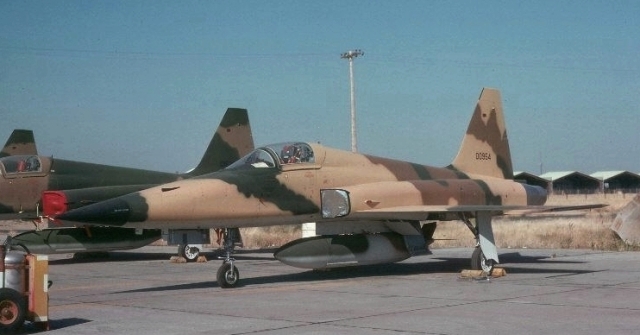
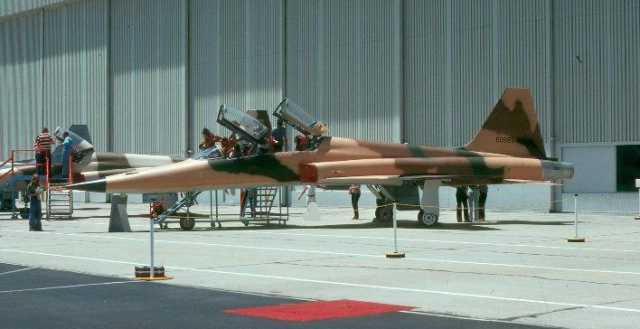
F-5E
00954 in USA before delivery, September 1974
F-5F 50683 on an open-day at Palmdale in May 1976
Photos: Archives the Northrop F-5 Enthusiast
First
flight of an Iranian Northrop F-5F two-seater was at Palmdale
in April 1976, delivery started in June 1976 and approximately 20
Northrop F-5F had been received by the end of 1976. The first example
of
Northrop F-5F was received in Iran in January 1974, while delivery
of Northrop F-5E was between 1974 and 1976.
Iran also placed at the end of 1976 an order for 1066 AIM-9P-1 air-to-missiles to equip both the
Tigers and the F-4E Phantoms.
By
1976 all Tiger units were operational; average operational availability
was 90%, over 500 pilots and 1'500 maintenance personnel had been
trained. The most critical problem was a shortage of trained technical
personnell in the logistical and maintenance area. This led to a high
number of US personnell (53 in 1974 official and contractor employeed) necessary to maintain
the fighters.
Iranian Northrop F-5E were of the
early aircracfts built, lacking advanced AN/ALR-46(V)2 radar
warning receiver and ALE chaff/flare dispensers ; ejection seat was a
Martin-Baker MB.IRQ7A and TACAN instead
of Northrop's own. It was planned
to relegate the Tiger to training duties in 1985 (though an upgrade was
to take pace earlier at their first fuselage overhaul at Iranian
Aircraft Industries in Teheran), replaced by
140 General Dynamics F-16A and F-16B in the operational units.
International exercises / War operation
An Iranian source states that a group of 4 (?) Northrop F-5E and at
least 1 Northrop F-5B were sent possibly in 1976 to Pakistan, where the Air Force was very interested to see the aircraft and
evaluate it against
their Sabre; only one or two excercisea were hold, ending with
Pakistani supremacy.
The year 1976 saw air-to-air an exercise against
Pakistani F-86E Mk6
In October 1977 air-to-air and air-to-ground gunnery
execises
followed at the Somiani range (Pakistan) against Pakistani
Shenyang F-6 from the 23rd Squadron, Northrop F-5E were based based at
Masroor AB.
(near Karachi),
The opposite way came Pakistani Shenyang F-6s from the 19th Squadron to Vahdati AB in September 1978 for an Iran-Pakistan
armament competition and Iranian
F-5s, together with Phantoms; a the two-days
exercise Midlink 77 against US Navy was hold against Phantoms of the aircraft carrier USS Midway.
The
only reported war operation took place in 1976 when several Northrop
F-5E/F-5F in two missions over Afghanistan were used in a tentative to reinstall the
Afghan king, ousted by a coup.
Replacement
Early
thougts about an Tiger replacement ended by an order for 160 General
Dynamics F-16s placed in 1976 and financial contribution to the
development of the F-18. Iran wished to replace Northrop F-5s with
General Dynamics F-16 in a one-to-one basis.
An order for 30 much advanced new Grumman F-14 was placed in January 1974, and a few months later
increased to a total of 80 aircrafts. First arrived In Iran in January 1976 and
12 additional in 1977. All best
pilots and maintenance personell were
used to train for the new aircrafts, leaving the Northrop F-5 equipped
units undermanned and with lower experienced personnell.
Political unrest
The Air Force was on the paper the best in the Middle
East, but by October 1978 the
Imperial government started to show signs of dissolvement under the pressure of opposition elements. Northrop started to
withdraw its employees and relatives from November 1978. Reports mention sabotage to electrical wiring harnesses inside approximately 20
F-5s during this time. Almost the whole Air Force had been virtually
grounded by late 1978.
Shah Reza Palevi left the
country on 16-01-79, the Imperial government fell on
12-02-79; thereaftere a non-Imperial
Provisional Govenment was established and the Islamic Republic of
Iran was officially declared
on 01-04-79, giving way to the establishment of the Islamic Republic of
Iran Air Force and the cancellationof all future programms.
Some Squadron patches can be found on Imperial Iranian AF site.
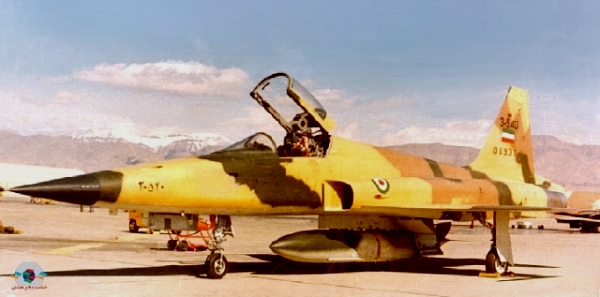
Northrop F-5E 3-540 00933 at
Mehrabad AFB
Photo: unknown
Taj Talee (Golden Crowns) aerobatic team
The Iranian
aerobatic team was named "Le Sabre" and based at Teheran-Mehrabad
AB till 1967, equipped
with 5 North American F-86F;
it was renamed "Golden
Crown" in 1968 on its re-equipment
with 5 Northrop F-5A,
reverting
to the original name and F-86F in the years 1969 (6 aircrafts)
and 1970 (5 aircrafts). The team was reverted to operation in
1971, equipped with 6 F-5As, but flying only 5 aircrafts in 1972 and
6 from 1973
to 1975.
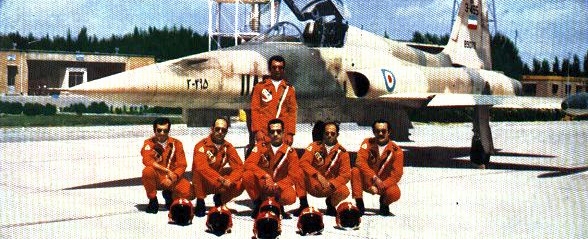
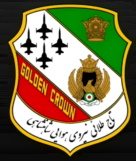
Golden Crown F-5A team
1973 in front of Northrop F-5A 2-345 89078 Photo:
unknown Emblem In
1976
q
It transitioned to 7 Northrop F-5E (also seen at le Bourget Air Show),
finally in 1977 with 8 aircrafts and was dissolved due to the
internal, revolutionary situation during the IRIAF period.
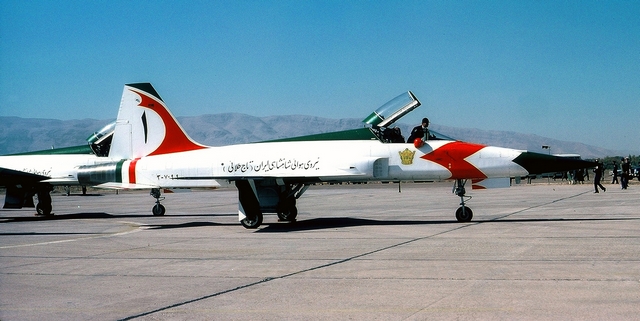
Northrop F-5E in Iranian colours (green, white, red) belonging to the Golden Crown, code 1, serial 3-7099.


 Last update 13-11-2023
Last update 13-11-2023












